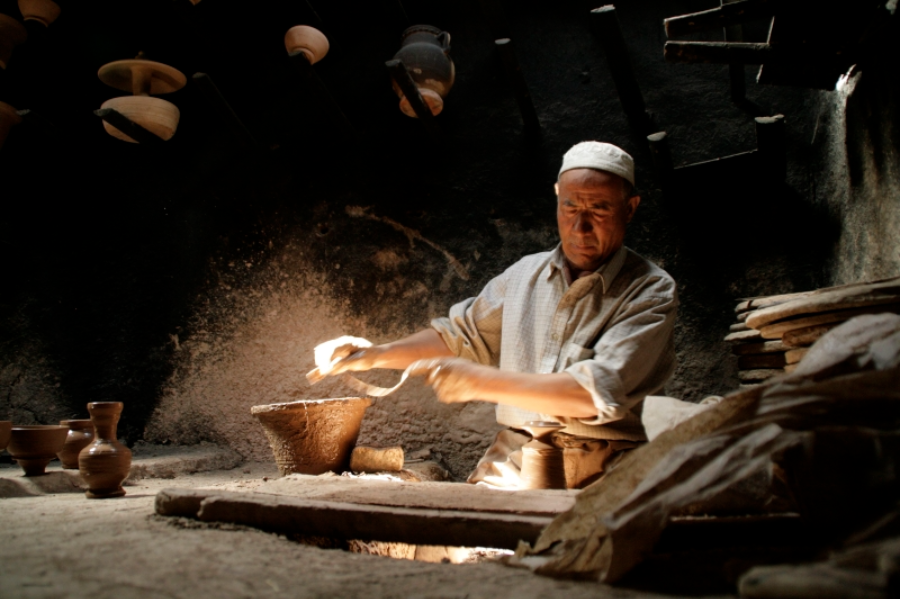Shiliuyun-Xinjiang Daily (Reporter Yin Lu) news: "In my eyes, they each hold a life of their own, none mirroring the other, just as we, each person, stand distinct..." On a spring noon, the sun has already given people a sense of warmth. In the Gaotai Ancient Homes scenic area in Kashi Prefecture, northwest China's Xinjiang Uygur Autonomous Region, 71-year-old artisan Tursun Rostan gently touched the shaped clay on the pottery wheel with his experienced hands.
Tursun's pottery creations are not just his childhood companions, but also the source of joy throughout his growth. They represent not only his mission of inheritance and development but also stand as a symbol of his personal accomplishment.
The persistence in the pottery-making technique has made him change from a child who played with mud following his father and elder to a national representative inheritor of the traditional Uygur pottery-making technique, which was included in the first representative list of State-level intangible cultural heritage items of China. Not long ago, he entered the list of 100 candidates for the 2023 "China Intangible Cultural Heritage Annual Person."

Photo shows Tursun Rostan. (Photo provided by Intangible Cultural Heritage Division of the Department of Cultural and Tourism of Xinjiang Uygur Autonomous Region)
Pottery, made from clay or a mixture of clay with other substances combined with water, then shaped, dried, and fired, is one of the hallmarks of human society's progression from the Paleolithic (Old Stone Age) to the Neolithic Period (New Stone Age), representing a significant technological revolution. Since its inception, people living in different regions have been crafting pottery that reflects local cultural characteristics, adapting their methods to the available materials, thus driving the evolution and transmission of this artisanal skill.
Tursun’s pottery workshop lies within the Gaotai Ancient Homes scenic area. Stepping into it feels like entering a "world of clay," where the residences, the workshop, and the people all exude a sense of tranquility, simplicity, and purity.
Tursun picked up a piece of clay and placed it on the slowly spinning pottery wheel, his hands gently shaping it as he waited for the graceful lines to emerge... Meng Tingting sat on a small wooden stool, watching Tursun work with a kind of enchanted fascination.
"This year’s Mother's Day, I want to give my mom a gift from Kashi, and the pottery work is very representative," said Meng Tingting, who traveled from Zhengzhou, Henan Province, to experience Xinjiang's spring. The pottery reminded her of the days when her mother accompanied her to pottery classes during her childhood, and she regretted not persisting with it. Tursun’s dedication deeply moved her. "The process of creating this piece of pottery allowed me to witness a long-missed and valuable spirit of craftsmanship."

Photo shows Tursun Rostan. (Photo provided by Intangible Cultural Heritage Division of the Department of Cultural and Tourism of Xinjiang Uygur Autonomous Region)
Through long periods of refinement and practice, Tursun has completely embedde the colors, patterns, and designs of pottery making in his heart. He never sketches or makes drafts, trusting that his hands, mind, and heart are one. "I rely solely on my feelings and experience to create the form I desire," he said. This inspiration is something he has accumulated since childhood. His father told him that as a pottery artisan, there are no ready-made pattern books available; if he wants to create something uniquely his own, he must use his eyes to seek inspiration from the world around him.
So, when he started learning pottery-making, Tursun relied on observation to find creative inspiration. He squatted by the river to observe the flow of water and the movements of fish. He stood in the forest to observe the shapes of various leaves. He collected flowers of different colors and tried to combine them. And he also picked grapes, gourds, wheat spikes, and other fruits to study their characteristics.
"On a piece of pottery, the patterns don't take up much space but are very eye-catching; they serve to bring the design to life. Therefore, it takes great care to satisfy customers," Tursun believes that the charm of pottery products lies in their simplicity and practicality. The patterns should be simplified to preserve the beauty of the design and convey a positive meaning.
Tursun's pottery workshop can produce more than 70 types of daily necessities and decorative items, including jars, pots, plates, bowls, bottles, vases, barrels, basins, lamps, and more.

Photo shows Tursun Rostan demonstrates the process of making pottery to the students. (Photo provided by Intangible Cultural Heritage Division of the Department of Cultural and Tourism of Xinjiang Uygur Autonomous Region)
The production process involves shaping the clay, carving patterns, drying, glazing, and firing. To this day, Tursun still adheres to the pottery-making steps and principles passed down from his ancestors. He never rushes the selection of clay quality, drying time, glazing method, or firing process, even a little. The most important advice he gives to his apprentices is also "not to cut corners."
Since Tursun’s pottery works were exhibited at the exhibition of China-Eurasia Expo more than a decade ago, his reputation in the industry has been growing, and many enthusiasts have come to learn his craft.
"I haven't had much schooling, but I understand my mission as an inheritor. I've received many official honors, which also come with responsibilities. I want to spend more time training apprentices so that they can earn a living and teach others." Tursun has imparted his skills to dozens of apprentices over the years in his workshop and through various heritage training programs. Among them are apprentices from Beijing, Shaanxi, Fujian, Zhejiang, and other regions, extending the reach of this traditional craft and giving him hope for the future of this "old skill."
(A written permission shall be obtained for reprinting, excerpting, copying and mirroring of the contents published on this website. Unauthorized aforementioned act shall be deemed an infringement, of which the actor shall be held accountable under the law.)









